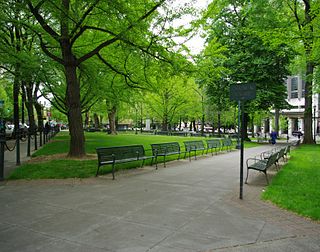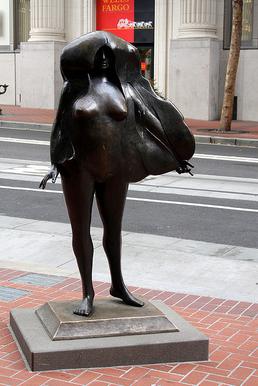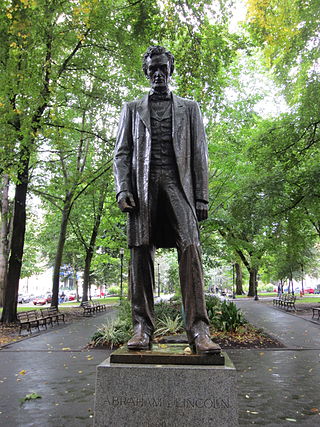
David Preston Thompson was an American businessman and politician in the Pacific Northwest. He was governor of the Idaho Territory from 1875 to 1876. A native of Ohio, he immigrated to the Oregon Territory in 1853. In Oregon, Thompson would become a wealthy business man, and served in the Oregon Legislative Assembly, as both a Republican and a Democrat, both before and after his time in Idaho, with election to both chambers of the legislature.

Roland Hinton Perry was an American sculptor and painter.

The Plaza Blocks, two courthouse squares known as Chapman Square and Lownsdale Square, are located in downtown Portland, Oregon, United States. The blocks are north of Terry Schrunk Plaza and east of City Hall. The northmost square is named after Daniel H. Lownsdale (1803—1862), a native Kentuckian who settled in Portland in 1845. The south square is named after legislator William W. Chapman (1808–1892), a Virginian settled in Portland in 1850.

Kvinneakt is an abstract bronze sculpture located on the Transit Mall of downtown Portland, Oregon. Designed and created by Norman J. Taylor between 1973 and 1975, the work was funded by TriMet and the United States Department of Transportation and was installed on the Transit Mall in 1977. The following year Kvinneakt appeared in the "Expose Yourself to Art" poster which featured future Mayor of Portland Bud Clark flashing the sculpture. It remained in place until November 2006 when it was removed temporarily during renovation of the Transit Mall and the installation of the MAX Light Rail on the mall.

Allow Me, also known as Umbrella Man, is a 1983 bronze sculpture by John Seward Johnson II, located in Pioneer Courthouse Square in Portland, Oregon, United States. The sculpture, one of seven Allow Me casts, was donated anonymously to the City of Portland in 1984 for display in the Square. It depicts a life-sized man dressed in a business suit, hailing a cab and holding an umbrella. Constructed from bronze, aluminum and stainless steel, the sculpture stands six feet, ten inches tall and weighs 460 pounds. The sculpture is one of many works of art generated by the city's Percent for Art program, and is considered part of the City of Portland and Multnomah County Public Art Collection courtesy of the Regional Arts & Culture Council.

Shemanski Fountain, also known as Rebecca at the Well, is an outdoor fountain with a bronze sculpture, located in the South Park Blocks of downtown Portland, Oregon, in the United States. The sandstone fountain was designed in 1925, completed in 1926, and named after Joseph Shemanski, a Polish immigrant and businessman who gave it to the city. Carl L. Linde designed the trefoil, which features a statue designed by Oliver L. Barrett. The sculpture, which was added to the fountain in 1928, depicts the biblical personage Rebecca. Shemanski Fountain includes two drinking platforms with three basins each, with one platform intended for use by dogs.

The Spanish–American War Soldier's Monument, also known as the Spanish–American War Memorial or simply Soldiers Monument, is an outdoor sculpture and war memorial monument honoring the dead of the 2nd Oregon Volunteer Infantry Regiment of the Spanish–American War and Philippine–American War. The monument was created by American artist Douglas Tilden and located in Lownsdale Square, in the Plaza Blocks of downtown Portland, Oregon. It features a bronze statue on a marble pedestal and granite base. The monument is part of the City of Portland and Multnomah County Public Art Collection courtesy of the Regional Arts & Culture Council.

A bronze statue of Abraham Lincoln by George Fite Waters was installed in Portland, Oregon's South Park Blocks, in the United States, until 2020. The 10-foot statue was donated by Henry Waldo Coe.

Fountain for Company H, also known as Second Oregon Company Volunteers, is a 1914 fountain and war memorial designed by John H. Beaver, installed in Portland, Oregon's Plaza Blocks, in the United States. Dedicated to the men of Company H of the 2nd Oregon Volunteer Infantry Regiment killed in service during the Spanish–American War, the limestone and bronze memorial was installed in Lownsdale Square in 1914. It is part of the City of Portland and Multnomah County Public Art Collection courtesy of the Regional Arts & Culture Council. The memorial has been included in published walking tours of Portland.

The Promised Land is an outdoor bronze sculpture by David Manuel, installed in 1993 in Chapman Square, in Portland, Oregon. It was de-accessioned in 2020 in response to vandalism and racial justice concerns during the George Floyd protests.

Talos No. 2 is an outdoor 1959–1977 bronze sculpture created by the American artist James Lee Hansen. It is located in the Transit Mall of downtown Portland, Oregon, in the United States.

Vera Katz, also known as Mayor, Vera Katz, is an outdoor bronze sculpture depicting Vera Katz created by American artist Bill Bane. Unveiled in 2006, it is located along the Eastbank Esplanade in Portland, Oregon. Katz, a former mayor of the city between 1993 and 2005, supported arts and culture during her tenure and established Oregon's Percent for Art program. She was also instrumental in developing the Eastbank Esplanade, which is named after her. The sculpture has received a mostly positive reception and has inspired people to adorn it with clothing, flowers and makeup.

A 1926–27 statue of George Washington by Italian American artist Pompeo Coppini, sometimes called George Washington, was installed in northeast Portland, Oregon, United States. The bronze sculpture was the second of three statues of Washington by the artist, following a similar statue installed in Mexico City in 1912 and preceding another installed on the University of Texas at Austin campus in February 1955. The Portland statue was created to commemorate the 1926 sesquicentennial of the Declaration of Independence and dedicated in 1927. It was part of the City of Portland and Multnomah County Public Art Collection courtesy of the Regional Arts & Culture Council. In June 2020, it was toppled by protestors.

A bronze sculpture of American pioneer, newspaper editor and historian Harvey W. Scott (1838–1910) by Gutzon Borglum, sometimes called Harvey Scott or Harvey W. Scott, was installed on Mount Tabor in Portland, Oregon, United States, until being toppled in October 2020.
The Theodore Roosevelt Memorial is a lost monument and sculpture commemorating the 26th president of the United States, Theodore Roosevelt, as well as veterans of the Spanish–American War. It was originally installed in Portland's Battleship Oregon Park. Designed by American artist Oliver L. Barrett, the 18-foot (5.5 m) memorial was erected in 1939, but disappeared in 1942 after being relocated temporarily during the construction of Harbor Drive. It featured a geometric tufa statue depicting a man not resembling Roosevelt, as well as a smaller realistic sculpture of him. The monument initially received a generally unfavorable reception, but was considered one of Barrett's best-known artworks.

Many artworks related to the Black Lives Matter movement were created in Portland, Oregon, United States, during local protests over the murder of George Floyd and other Black Americans. Oregon Arts Watch contextualized the artistic works, stating that a "whitewashed pre-COVID lens" on American life, which obscured systemic racism, had been "cracked", and describing artists' response to racial violence being brought into the public eye was a "marathon, not a sprint".

A 4 foot bust of York, the only African American on the Lewis and Clark Expedition, was installed in Portland, Oregon's Mount Tabor Park, in the United States, from February to July 2021. The artist stayed anonymous at first, but after the bust was removed he revealed himself as Todd McGrain. McGrain was a student of Darrell Millner, Portland State University professor of history and Black Studies. The bust appeared on February 20, replacing the statue of Harvey W. Scott, which had been toppled on October 20, 2020. McGrain did not seek city permission to install the bust, which McGrain expected to be temporary; on June 11 the city announced that it would remove the bust.

The "Nightmare Elk" was a metal sculpture of an elk, temporarily installed in Portland, Oregon.






















